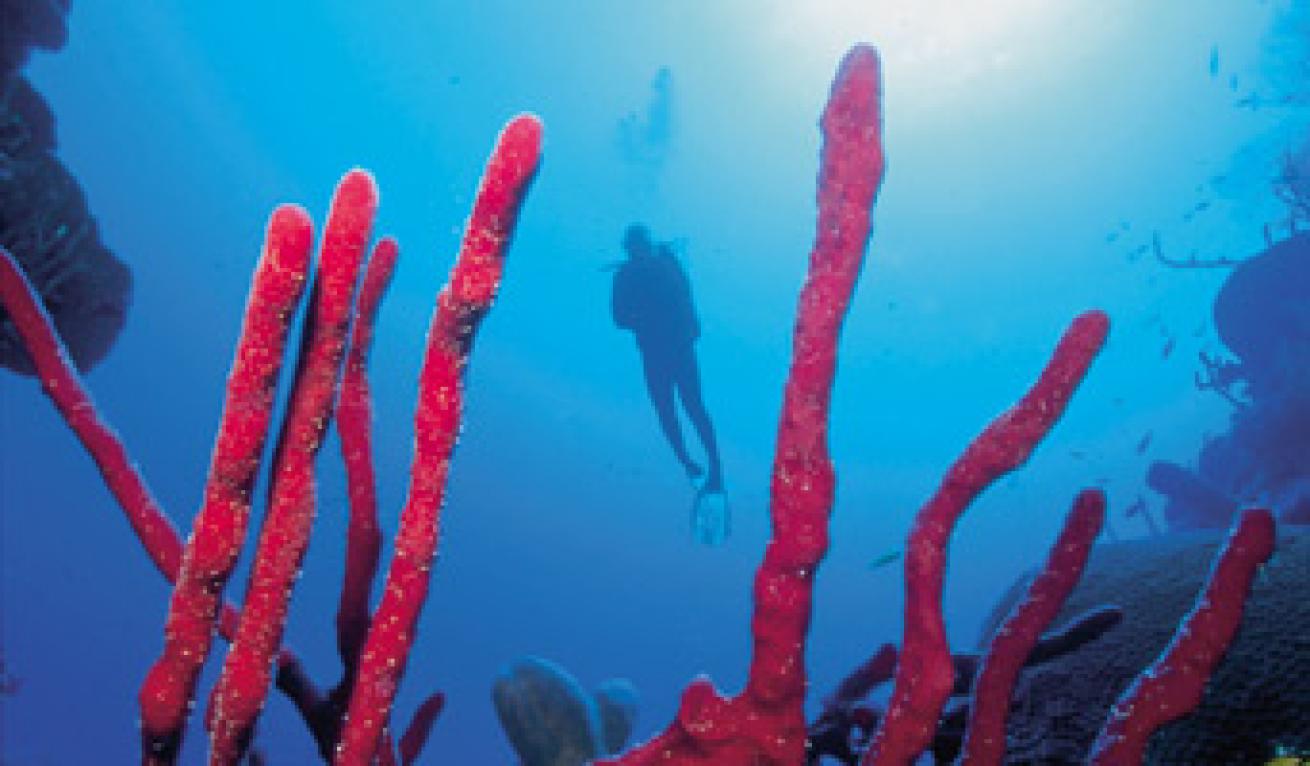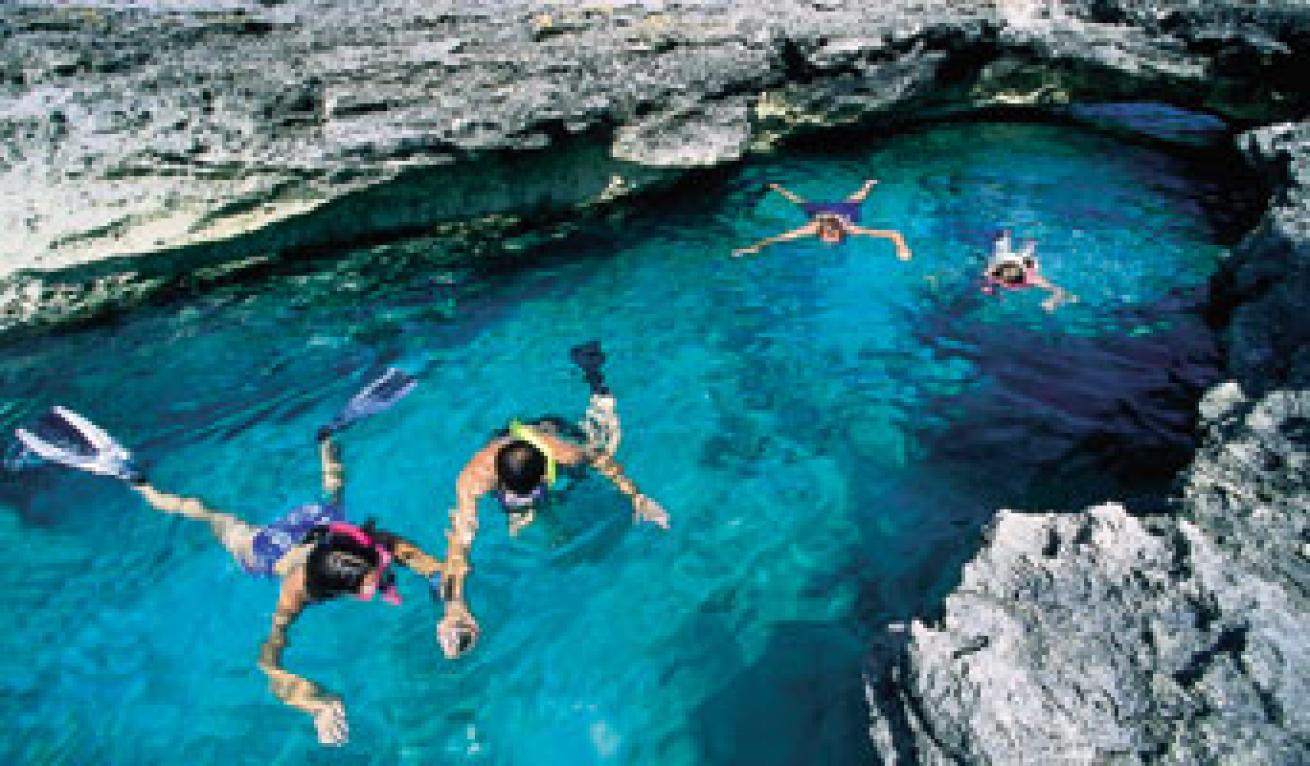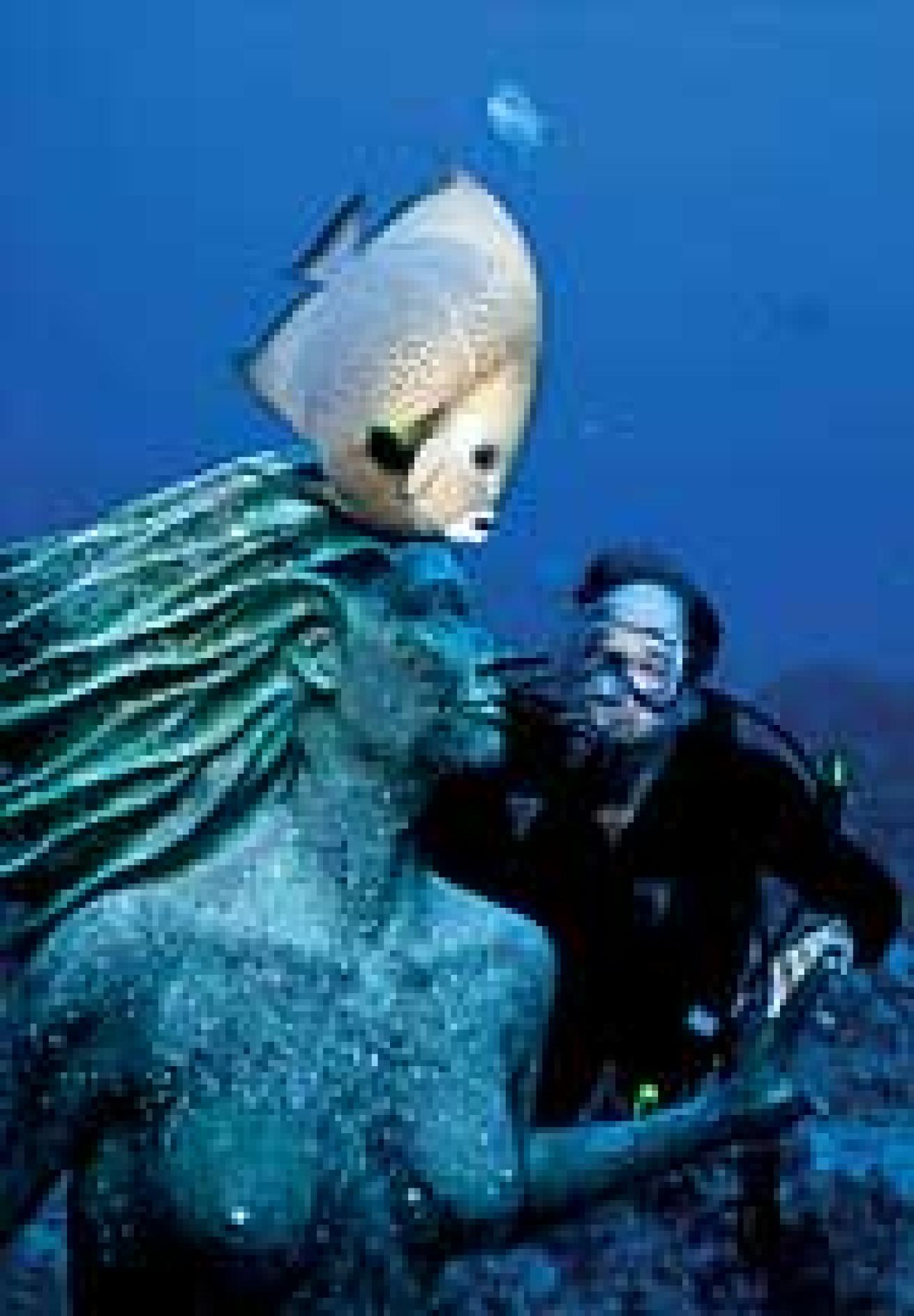Grand Cayman Island
 |
July 2001
By the Readers and Editors of Scuba Diving
||Related Product
|---
Reef Fish Identification|
|The Unofficial Guide to the World's Best Diving Vacations|
Since the 1950s, Grand Cayman has enjoyed a monopoly of sorts on the affections of divers. It was the very first Caribbean dive destination and remains one of the most popular to this day. According to our latest Readers' Choice awards, Grand Cayman holds the number two spot on our readers' list of Top 10 Most Popular Caribbean Dive Destinations.
Read on to find out why, and be sure to count up all the Readers' Choice Award icons. They're your at-a-glance guide to the charms of Grand Cayman and your key to winning a limited edition Stahlsac mesh dive bag.
Great Wall Diving
Part of what makes Grand Cayman so addictive (as if you didn't already know) is the feeling of weightlessness that only wall diving provides. The experience of soaring out over the drop-off, and seeing the bottom drop out from under you, is still one of diving's greatest rushes. And with dramatic walls on every side, it's no wonder that Grand Cayman earned a spot on the list of Top Five Best Wall Diving Destinations in the Caribbean. Only the Cayman Sister Islands, Cayman Brac and Little Cayman, rated higher.
Grand Cayman is 22 miles long by eight miles wide and rises straight from the mid-Caribbean seafloor. The most popular diving is on the west wall, where the conditions are usually the calmest, and the wall starts in just 50 feet of water. The north is dived less frequently, yet boasts some of the best dives on the island and some of the greatest chances of seeing big stuff. The south is usually where operators go when the west or north is blown out, but don't think for a second that these awesome underwater walls and terraces are second-rate. And the East End is almost exclusively the domain of dive resorts located on that side of the island. It sees more surf, wind and current than any other side, but you also get the chance to see more dramatic coral formations, and unique encounters with reef sharks add to the excitement.
Warm, Clear Water
For those divers who don't appreciate low-vis diving in a dry suit, take solace. Grand Cayman water temps are typical Caribbean, ranging from the high 70Fs in winter (OK, you'll probably want a 2- or 3-millimeter wetsuit) to low- to mid-80Fs in summer (skin only). And in many cases, your visibility will be limited only by your eyesight. In fact, Grand Cayman was rated number two on our Readers' Choice list of Top Five Caribbean Destinations for Visibility.
 |
Safe, Family-Friendly Atmosphere
You're not looking over your shoulder when you're on Grand Cayman. You're not accosted on the beach or hustled to buy drugs. It's wild yet mild—you can experience adventure while enjoying all the comforts of a well-developed destination. And the island has gone to great lengths and spent lots of money to keep it that way.
Beaches
Nine out of 10 resorts on Grand Cayman—with the exception of West Bay and East End—are located either directly on Seven Mile Beach or across the street from it. It's the biggest and best-known beach on the island, rightfully one of the most popular strands in the entire Caribbean. Park your butt, apply sunscreen and relax—if that's your gig. Bring a mask and snorkel if it isn't. Or try a shore dive—Cobalt Coast and Turtle Reef in the northwest, the Cemetery, wreck of the Cali, Eden Rock, Seaview Hotel, Sunset House and Coconut Harbour. Some dedicated dive resorts even make tanks available for do-it-yourself shore diving. In fact, Grand Cayman is on the list of Top Five Best Caribbean Shore Diving Destinations.
Restaurants, Shopping, Nightlife
It's funny how an island that serves up all the familiar franchises of home—Burger King, Subway, Outback—also possesses some of the region's most upscale eateries. From fresh seafood to Italian, island-style to Thai, no doubt you'll find what you hunger for. And you'll find no shortage of shopping opportunities along Seven Mile Beach.
Convenient Connections
With more than 100 flights coming into Grand Cayman each week, it's as easy as flying to Peoria (though a lot warmer). The island is served by a handful of domestic airlines—American, Delta, Northwest, US Airways and most recently, Continental—as well as British Airways, Air Jamaica and the islands' national carrier, Cayman Airways.
A Dive Industry With History
Grand Cayman is a scuba original, so it had a bit of a head start on other dive destinations. Just when people in many other parts of the globe were looking at dive gear with puzzled expressions, divers were discovering Grand Cayman's unique underwater topography. And long before big animal encounters were cool, divers and snorkelers were feeding throngs of southern stingrays at Stingray City and Sandbar. In fact, our readers named Stingray City one of the Top 10 Favorite Dive Sites in the World . Add it all up, and it's easy to see why Grand Cayman is consistently in our list of Top 10 Best Overall Caribbean Destinations.
 |
For Advanced Divers Only
Many divers look to the Sister Islands—Little Cayman and Cayman Brac—for advanced diving opportunities. But Grand Cayman offers enough challenges to keep advanced divers', photographers' and techies' computers humming.
-
Technical Diving. Grand Cayman has long been known as a beginner-friendly dive destination, but recent amendments to the island's watersports association's regulations allow operators to take technical divers to new depths. The island is experiencing a bit of a technical renaissance, as the introduction of new techniques and tools allows divers to rediscover old dive sites, and find new ones. Leading the way is Dive Tech, Grand Cayman's technical diving headquarters, offering tech diving and instruction, rebreather diving and instruction, free diving and instruction, as well as underwater scooters. Ocean Frontiers and Sunset House also offer a taste of tech diving with "Rebreather Experience" programs.
-
12-Mile Bank Trips. When the weather's right, and usually only in summer, you may be able to get out to this spot—yep, 12 miles from the island. The seven-by-one-mile submerged seamount affords the chance to see the big fish, as well as a recently discovered 250-foot wreck that went down in 1982. Offered by Ocean Frontiers.
-
Self-Guided Computer Diving. Grand Cayman dive operators recognize that experienced divers and return guests may want more freedom to dive their own profiles. Bob Soto's Diving, for example, offers the "Gold Card Program," which allows advanced buddy groups to dive computer profiles without a guide.
-
Photography. Even if you've never picked up a camera before, the photo pros at Grand Cayman dive shops will have you juggling f-stops and shutter speeds in no time. Cathy Church's Underwater Photo Center and Gallery offers complete underwater photo sales, instruction and film processing. Fisheye of Cayman, which claims to be Cayman's "first photo-dive center," offers underwater photo and video rental and instruction, as well as film processing. Red Sail Sports also offers underwater photography and video instruction.
Dive In: Grand Cayman
 |
||
Getting There: A growing number of U.S. carriers make the quick bounce over Cuba to Grand Cayman. Delta is the latest addition, with a daily flight to and from Atlanta.
Weather: Expect daytime highs in the 70Fs in winter, and in the mid- to high 80Fs in the summer.
Water Conditions: Temperatures drop into the high 70Fs in winter and peak in the low 80Fs in summer. Visibility varies from 80 to 200 feet, with peak water clarity occurring during the calm summer months.
Documents: Passports are recommended, though U.S. and Canadian citizens can get by with a birth certificate and photo ID.
Money Matters: The Cayman dollar (CI$) is worth more than the U.S. dollar. The fixed rate is CI$1 to US$1.25. U.S. dollars (and major credit cards) are widely accepted, but expect change in local currency.
Electricity: 110 volts, 60 cycles, the same as the United States and Canada.
Telephone: The area code of the Cayman Islands is 345.
Food and Water: Tap water is safe to drink.
Just In Case: Grand Cayman has a recompression chamber staffed 24 hours a day. Telephone: 949-2989.

July 2001
By the Readers and Editors of Scuba Diving
|| [Reef Fish Identification](http://www.amazon.com/exec/obidos/ASIN/1878348302/rodalesscubadivi/002-7482067-0655244?dev-t=D68HUNXKLHS4J%26camp=2025%26link_code=xm2)| |[The Unofficial Guide to the World's Best Diving Vacations](http://www.amazon.com/exec/obidos/ASIN/0764562207/rodalesscubadivi/002-7482067-0655244?dev-t=D68HUNXKLHS4J%26camp=2025%26link_code=xm2)| |
Since the 1950s, Grand Cayman has enjoyed a monopoly of sorts on the affections of divers. It was the very first Caribbean dive destination and remains one of the most popular to this day. According to our latest Readers' Choice awards, Grand Cayman holds the number two spot on our readers' list of Top 10 Most Popular Caribbean Dive Destinations.
Read on to find out why, and be sure to count up all the Readers' Choice Award icons. They're your at-a-glance guide to the charms of Grand Cayman and your key to winning a limited edition Stahlsac mesh dive bag.
Great Wall Diving
Part of what makes Grand Cayman so addictive (as if you didn't already know) is the feeling of weightlessness that only wall diving provides. The experience of soaring out over the drop-off, and seeing the bottom drop out from under you, is still one of diving's greatest rushes. And with dramatic walls on every side, it's no wonder that Grand Cayman earned a spot on the list of Top Five Best Wall Diving Destinations in the Caribbean. Only the Cayman Sister Islands, Cayman Brac and Little Cayman, rated higher.
Grand Cayman is 22 miles long by eight miles wide and rises straight from the mid-Caribbean seafloor. The most popular diving is on the west wall, where the conditions are usually the calmest, and the wall starts in just 50 feet of water. The north is dived less frequently, yet boasts some of the best dives on the island and some of the greatest chances of seeing big stuff. The south is usually where operators go when the west or north is blown out, but don't think for a second that these awesome underwater walls and terraces are second-rate. And the East End is almost exclusively the domain of dive resorts located on that side of the island. It sees more surf, wind and current than any other side, but you also get the chance to see more dramatic coral formations, and unique encounters with reef sharks add to the excitement.
Warm, Clear Water
For those divers who don't appreciate low-vis diving in a dry suit, take solace. Grand Cayman water temps are typical Caribbean, ranging from the high 70Fs in winter (OK, you'll probably want a 2- or 3-millimeter wetsuit) to low- to mid-80Fs in summer (skin only). And in many cases, your visibility will be limited only by your eyesight. In fact, Grand Cayman was rated number two on our Readers' Choice list of Top Five Caribbean Destinations for Visibility.
|
Safe, Family-Friendly Atmosphere
You're not looking over your shoulder when you're on Grand Cayman. You're not accosted on the beach or hustled to buy drugs. It's wild yet mild—you can experience adventure while enjoying all the comforts of a well-developed destination. And the island has gone to great lengths and spent lots of money to keep it that way.
Beaches
Nine out of 10 resorts on Grand Cayman—with the exception of West Bay and East End—are located either directly on Seven Mile Beach or across the street from it. It's the biggest and best-known beach on the island, rightfully one of the most popular strands in the entire Caribbean. Park your butt, apply sunscreen and relax—if that's your gig. Bring a mask and snorkel if it isn't. Or try a shore dive—Cobalt Coast and Turtle Reef in the northwest, the Cemetery, wreck of the Cali, Eden Rock, Seaview Hotel, Sunset House and Coconut Harbour. Some dedicated dive resorts even make tanks available for do-it-yourself shore diving. In fact, Grand Cayman is on the list of Top Five Best Caribbean Shore Diving Destinations.
Restaurants, Shopping, Nightlife
It's funny how an island that serves up all the familiar franchises of home—Burger King, Subway, Outback—also possesses some of the region's most upscale eateries. From fresh seafood to Italian, island-style to Thai, no doubt you'll find what you hunger for. And you'll find no shortage of shopping opportunities along Seven Mile Beach.
Convenient Connections
With more than 100 flights coming into Grand Cayman each week, it's as easy as flying to Peoria (though a lot warmer). The island is served by a handful of domestic airlines—American, Delta, Northwest, US Airways and most recently, Continental—as well as British Airways, Air Jamaica and the islands' national carrier, Cayman Airways.
A Dive Industry With History
Grand Cayman is a scuba original, so it had a bit of a head start on other dive destinations. Just when people in many other parts of the globe were looking at dive gear with puzzled expressions, divers were discovering Grand Cayman's unique underwater topography. And long before big animal encounters were cool, divers and snorkelers were feeding throngs of southern stingrays at Stingray City and Sandbar. In fact, our readers named Stingray City one of the Top 10 Favorite Dive Sites in the World . Add it all up, and it's easy to see why Grand Cayman is consistently in our list of Top 10 Best Overall Caribbean Destinations.
|
For Advanced Divers Only
Many divers look to the Sister Islands—Little Cayman and Cayman Brac—for advanced diving opportunities. But Grand Cayman offers enough challenges to keep advanced divers', photographers' and techies' computers humming.
Technical Diving. Grand Cayman has long been known as a beginner-friendly dive destination, but recent amendments to the island's watersports association's regulations allow operators to take technical divers to new depths. The island is experiencing a bit of a technical renaissance, as the introduction of new techniques and tools allows divers to rediscover old dive sites, and find new ones. Leading the way is Dive Tech, Grand Cayman's technical diving headquarters, offering tech diving and instruction, rebreather diving and instruction, free diving and instruction, as well as underwater scooters. Ocean Frontiers and Sunset House also offer a taste of tech diving with "Rebreather Experience" programs.
12-Mile Bank Trips. When the weather's right, and usually only in summer, you may be able to get out to this spot—yep, 12 miles from the island. The seven-by-one-mile submerged seamount affords the chance to see the big fish, as well as a recently discovered 250-foot wreck that went down in 1982. Offered by Ocean Frontiers.
Self-Guided Computer Diving. Grand Cayman dive operators recognize that experienced divers and return guests may want more freedom to dive their own profiles. Bob Soto's Diving, for example, offers the "Gold Card Program," which allows advanced buddy groups to dive computer profiles without a guide.
Photography. Even if you've never picked up a camera before, the photo pros at Grand Cayman dive shops will have you juggling f-stops and shutter speeds in no time. Cathy Church's Underwater Photo Center and Gallery offers complete underwater photo sales, instruction and film processing. Fisheye of Cayman, which claims to be Cayman's "first photo-dive center," offers underwater photo and video rental and instruction, as well as film processing. Red Sail Sports also offers underwater photography and video instruction.
Dive In: Grand Cayman
|<
table>

Getting There: A growing number of U.S. carriers make the quick bounce over Cuba to Grand Cayman. Delta is the latest addition, with a daily flight to and from Atlanta.
Weather: Expect daytime highs in the 70Fs in winter, and in the mid- to high 80Fs in the summer.
Water Conditions: Temperatures drop into the high 70Fs in winter and peak in the low 80Fs in summer. Visibility varies from 80 to 200 feet, with peak water clarity occurring during the calm summer months.
Documents: Passports are recommended, though U.S. and Canadian citizens can get by with a birth certificate and photo ID.
Money Matters: The Cayman dollar (CI$) is worth more than the U.S. dollar. The fixed rate is CI$1 to US$1.25. U.S. dollars (and major credit cards) are widely accepted, but expect change in local currency.
Electricity: 110 volts, 60 cycles, the same as the United States and Canada.
Telephone: The area code of the Cayman Islands is 345.
Food and Water: Tap water is safe to drink.
Just In Case: Grand Cayman has a recompression chamber staffed 24 hours a day. Telephone: 949-2989.










